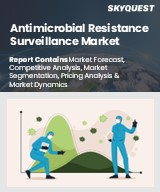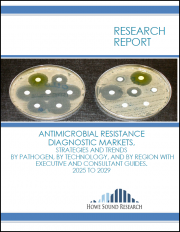
|
시장보고서
상품코드
1638737
항생제 내성 진단 시장 전망 : 기회, 성장 촉진요인, 산업 동향 분석 및 예측(2024-2032년)Antimicrobial Resistance Diagnostics Market Opportunity, Growth Drivers, Industry Trend Analysis, and Forecast 2024 to 2032 |
||||||
세계의 항생제 내성 진단 시장은 2023년에 44억 달러로 평가되어 2024년부터 2032년에 걸쳐 CAGR 6.3% 이상으로 확대될 것으로 예측되고 있습니다.
이 시장은 항생제 내성 감염의 발생률 증가, 개인 맞춤형 치료에 대한 수요 증가, 진단 기술의 상당한 발전에 의해 주도되고 있습니다.
시장은 기기 및 소모품과 키트 및 시약의 두 가지 주요 제품 카테고리로 나뉩니다. 2023년에는 키트 및 시약 부문이 28억 달러의 가치로 시장을 주도했습니다. 이러한 진단 키트와 시약은 항생제 내성 박테리아 균주를 신속하고 정확하게 식별하는 데 중요한 역할을 합니다. 내성을 조기에 발견하는 것은 효과적인 치료 요법을 보장하고 내성 발생의 주요 요인인 항생제 오남용을 줄이는 데 필수적입니다. 보건 기관의 이니셔티브와 같은 글로벌 및 지역적 노력으로 인해 AMR 진단 도구에 대한 수요가 더욱 증가하고 있습니다.
항생제 내성 진단에 사용되는 기술을 살펴보면 시장은 미생물 배양, 면역 분석, PCR, 차세대 염기서열 분석(NGS), 질량 분석, 신속 및 현장 진단 및 기타 기술로 세분화됩니다. 미생물 배양 부문은 2023년에 31.1%의 상당한 점유율을 차지할 것으로 예상됩니다. 미생물 배양의 기술 발전으로 내성 균주 식별의 속도, 정확성, 특이성이 크게 향상되었습니다. 배양 시스템의 자동화로 진단에 필요한 시간이 현저히 단축되어 배양 기반 방법이 항생제 내성 박테리아를 검출하는 데 더욱 신뢰할 수 있게 되었으며, 이는 시장 성장을 더욱 촉진할 것으로 예상됩니다.
| 시장 범위 | |
|---|---|
| 시작연도 | 2023년 |
| 예측연도 | 2024-2032년 |
| 시작 시장가치 | 44억 달러 |
| 예측 시장가치 | 76억 달러 |
| 연평균성장율(CAGR) | 6.3% |
미국의 항생제 내성 진단 시장은 연평균 6.2%의 성장률로 2032년까지 31억 달러에 달할 것으로 예상됩니다. 항생제 내성 박테리아 퇴치를 위한 국가 행동 계획(CARB)과 같이 항생제 내성 퇴치에 초점을 맞춘 미국 정부의 이니셔티브는 AMR 진단 역량 확장에 기여했습니다. 이러한 이니셔티브는 진단 기술의 발전을 지원하고 해당 분야의 연구 및 개발을 위한 자금을 제공합니다. 또한 미국 보건복지부는 AMR 진단, 연구 및 새로운 항생제 개발을 강화하기 위해 상당한 투자를 약속하여 시장 성장을 더욱 촉진하고 있습니다.
목차
제1장 조사 방법과 조사 범위
제2장 주요 요약
제3장 업계 인사이트
- 생태계 분석
- 업계에 미치는 영향요인
- 성장 촉진요인
- 약제 내성 감염증 증가
- 진단 기술의 진보
- 의료시설에 있어서의 인식 향상과 트레이닝 프로그램
- 업계의 잠재적 위험 및 과제
- 높은 개발, 도입 비용
- 대체 솔루션과의 경쟁
- 성장 촉진요인
- 성장 가능성 분석
- 규제 상황
- 향후 시장 동향
- 기술 동향
- Porter's Five Forces 분석
- PESTEL 분석
제4장 경쟁 구도
- 소개
- 기업 점유율 분석
- 기업 매트릭스 분석
- 주요 시장 기업의 경쟁 분석
- 경쟁 포지셔닝 매트릭스
- 전략 대시보드
제5장 시장 추계 및 예측 : 제품 유형별(2021-2032년)
- 주요 동향
- 키트 및 시약
- 기기, 소모품
제6장 시장 추계 및 예측 : 기술별(2021-2032년)
- 주요 동향
- 미생물 배양
- 면역 측정
- 중합효소 연쇄반응(PCR)
- 차세대 염기서열분석(NGS)
- 질량 분석
- 신속 및 현장 진료
- 기타 기술
제7장 시장 추계 및 예측 : 병원체 유형별(2021-2032년)
- 주요 동향
- 약제 내성 폐렴구균(DRSP)
- 약제 내성 캄필로박터(DRC)
- 크로스트리듐 디피실(CD)
- 약제 내성 임균(DRNG)
- 기타 병원균 유형
제8장 시장 추계 및 예측 : 최종사용자별(2021-2032년)
- 주요 동향
- 병원, 진료소
- 진단 실험실
- 제약, 바이오테크놀러지 기업
- 기타 최종 사용자
제9장 시장 추계 및 예측 : 지역별(2021-2032년)
- 주요 동향
- 북미
- 미국
- 캐나다
- 유럽
- 독일
- 영국
- 프랑스
- 스페인
- 이탈리아
- 네덜란드
- 아시아태평양
- 중국
- 일본
- 인도
- 호주
- 한국
- 라틴아메리카
- 브라질
- 멕시코
- 아르헨티나
- 중동 및 아프리카
- 남아프리카
- 사우디아라비아
- 아랍에미리트(UAE)
제10장 기업 프로파일
- Abbott Laboratories
- Accelerated Diagnostics, USA
- Alifax
- Bio-Rad Laboratories
- BioMerieux
- Beckman Coulter
- Becton, Dickinson and Company
- F. Hoffmann-La Roche
- GeneFluidics
- Molsid
- Thermo Fisher Scientific
- Vela Diagnostics
The Global Antimicrobial Resistance Diagnostics Market was valued at USD 4.4 billion in 2023 and is projected to expand at a CAGR of over 6.3% from 2024 to 2032. The market is driven by the growing incidence of antibiotic-resistant infections, the increasing demand for personalized treatments, and significant advancements in diagnostic technologies.
The market is divided into two main product categories: instruments & consumables and kits & reagents. In 2023, the kits & reagents segment led the market with a value of USD 2.8 billion. These diagnostic kits and reagents play a crucial role in the rapid and accurate identification of antibiotic-resistant bacterial strains. Early detection of resistance is essential for ensuring effective treatment regimens and reducing the overuse of antibiotics, which is a primary factor in the development of resistance. Global and regional efforts, such as initiatives from health organizations, are further driving the demand for AMR diagnostic tools.
When examining the technologies used in antimicrobial resistance diagnostics, the market is segmented into microbiology culture, immunoassay, PCR, next-generation sequencing (NGS), mass spectrometry, rapid & point-of-care diagnostics, and other technologies. The microbiology culture segment held a significant share of 31.1% in 2023. Technological advancements in microbial culture have greatly improved the speed, accuracy, and specificity of identifying resistant strains. The automation of culture systems has notably reduced the time required for diagnostics, making culture-based methods more reliable in detecting antibiotic-resistant bacteria, which is expected to further propel market growth.
| Market Scope | |
|---|---|
| Start Year | 2023 |
| Forecast Year | 2024-2032 |
| Start Value | $4.4 Billion |
| Forecast Value | $7.6 Billion |
| CAGR | 6.3% |
U.S. antimicrobial resistance diagnostic market is projected to grow at a CAGR of 6.2%, reaching USD 3.1 billion by 2032. U.S. government initiatives focused on combating antibiotic resistance, such as the National Action Plan for Combating Antibiotic-Resistant Bacteria (CARB), have contributed to the expansion of AMR diagnostic capabilities. These initiatives support advancements in diagnostic technologies and provide funding for research and development in the field. Additionally, the U.S. Department of Health and Human Services has committed substantial investments to enhance AMR diagnostics, research, and the development of novel antibiotics, further boosting market growth.
Table of Contents
Chapter 1 Methodology & Scope
- 1.1 Market scope & definitions
- 1.2 Research design
- 1.2.1 Research approach
- 1.2.2 Data collection methods
- 1.3 Base estimates & calculations
- 1.3.1 Base year calculation
- 1.3.2 Key trends for market estimation
- 1.4 Forecast model
- 1.5 Primary research and validation
- 1.5.1 Primary sources
- 1.5.2 Data mining sources
Chapter 2 Executive Summary
- 2.1 Industry 360° synopsis
Chapter 3 Industry Insights
- 3.1 Industry ecosystem analysis
- 3.2 Industry impact forces
- 3.2.1 Growth drivers
- 3.2.1.1 Increasing incidence of drug-resistant infection
- 3.2.1.2 Advancement in diagnostic technology
- 3.2.1.3 Rising awareness and training programs in healthcare facilities
- 3.2.2 Industry pitfalls & challenges
- 3.2.2.1 High development and implementation cost
- 3.2.2.2 Competition from alternative solutions
- 3.2.1 Growth drivers
- 3.3 Growth potential analysis
- 3.4 Regulatory landscape
- 3.5 Future market trends
- 3.6 Technology landscape
- 3.7 Porter's analysis
- 3.8 PESTEL analysis
Chapter 4 Competitive Landscape, 2023
- 4.1 Introduction
- 4.2 Company market share analysis
- 4.3 Company matrix analysis
- 4.4 Competitive analysis of major market players
- 4.5 Competitive positioning matrix
- 4.6 Strategy dashboard
Chapter 5 Market Estimates and Forecast, By Product Type, 2021 - 2032 ($ Mn)
- 5.1 Key trends
- 5.2 Kits & reagents
- 5.3 Instruments & consumables
Chapter 6 Market Estimates and Forecast, By Technology, 2021 - 2032 ($ Mn)
- 6.1 Key trends
- 6.2 Microbiology culture
- 6.3 Immunoassay
- 6.4 Polymerase chain reaction (PCR)
- 6.5 Next generation sequencing (NGS)
- 6.6 Mass spectrometry
- 6.7 Rapid & point of care
- 6.8 Other technologies
Chapter 7 Market Estimates and Forecast, By Pathogen Type, 2021 - 2032 ($ Mn)
- 7.1 Key trends
- 7.2 Drug-resistant streptococcus pneumoniae (DRSP)
- 7.3 Drug-resistant campylobacter (DRC)
- 7.4 Clostridium difficile (CD)
- 7.5 Drug-resistant neisseria gonorrhoeae (DRNG)
- 7.6 Other pathogen types
Chapter 8 Market Estimates and Forecast, By End Use, 2021 - 2032 ($ Mn)
- 8.1 Key trends
- 8.2 Hospitals & clinics
- 8.3 Diagnostic laboratories
- 8.4 Pharmaceutical & biotechnology companies
- 8.5 Other end users
Chapter 9 Market Estimates and Forecast, By Region, 2021 - 2032 ($ Mn)
- 9.1 Key trends
- 9.2 North America
- 9.2.1 U.S.
- 9.2.2 Canada
- 9.3 Europe
- 9.3.1 Germany
- 9.3.2 UK
- 9.3.3 France
- 9.3.4 Spain
- 9.3.5 Italy
- 9.3.6 Netherlands
- 9.4 Asia Pacific
- 9.4.1 China
- 9.4.2 Japan
- 9.4.3 India
- 9.4.4 Australia
- 9.4.5 South Korea
- 9.5 Latin America
- 9.5.1 Brazil
- 9.5.2 Mexico
- 9.5.3 Argentina
- 9.6 Middle East and Africa
- 9.6.1 South Africa
- 9.6.2 Saudi Arabia
- 9.6.3 UAE
Chapter 10 Company Profiles
- 10.1 Abbott Laboratories
- 10.2 Accelerated Diagnostics, USA
- 10.3 Alifax
- 10.4 Bio-Rad Laboratories
- 10.5 BioMerieux
- 10.6 Beckman Coulter
- 10.7 Becton, Dickinson and Company
- 10.8 F. Hoffmann-La Roche
- 10.9 GeneFluidics
- 10.10 Molsid
- 10.11 Thermo Fisher Scientific
- 10.12 Vela Diagnostics



















